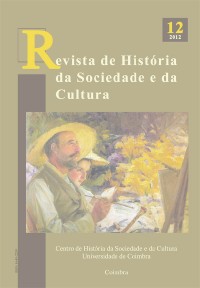Please use this identifier to cite or link to this item:
https://hdl.handle.net/10316.2/39429| Title: | “Estas cousas Señora filha vos peço e encomemdo”: a imagem de consorte na família real portuguesa a partir das instruções de D. Manuel para D. Beatriz (1504-1538) | Authors: | Silva, João Eusébio | Keywords: | 16th Century;Political Culture;Royal Household;Queen of Portugal;Beatriz;Duchess of Savoy;Século XVI;Cultura política;Casa real;Rainha de Portugal;Beatriz;Duquesa de Saboia | Issue Date: | 2012 | Publisher: | Centro de História da Sociedade e da Cultura | Abstract: | Em Agosto de 1521 a armada que transportava D. Beatriz de Portugal, duquesa de
Saboia, zarpava do Tejo rumo a Nice. A bordo seguia a filha de D. Manuel de Portugal com
um numeroso e representativo séquito e dote, exemplo do que a coroa portuguesa tinha de
melhor em luxo e aparato. Este era de resto um dos mecanismos utilizados por D. Manuel
I na afirmação do seu poder: a utilização dos símbolos e das imagens em torno da família
real como forma de afirmação política e social da coroa. Seguindo esta linha de pensamento
havia o monarca Português escrito as suas Instrucções para a sua filha que agora casava,
documento ímpar na análise do modelo de consorte régia no século XVI, para lá daquele que
nos é dado pela cronística e pelos tratadístas. A partir desta preciosa fonte escrita pelo rei de
Portugal do que se esperava de uma princesa, juntamente com apontamentos da vida desta
infanta de Portugal e da sua mãe, D. Maria de Aragão, rainha de Portugal, pode-se reconstruir
as linhas que ditavam a conduta de vida destas mulheres tão próximas dos centros de poder,
mas que surgem por diversas vezes como meras “sombras” na história. On August 1521, the fleet transporting D. Beatriz of Portugal, duchess of Savoy, set sail from the Tagus River to Nice. On board was the daughter of D.Manuel of Portugal with an enormous entourage and an impressive dowry, showcasing the luxury and the grandeur of the Portuguese crown. This was after all one of the ways D. Manuel used as a confirmation of his power: the use of the symbols and images surrounding the royal family as a form of political and social affirmation of the crown. Following this line of thought, the Portuguese king had written his Instrucções for his marrying daughter, an unique document when analyzing the model of the royal consort in the 16th century, beyond what is given to us by the chroniclers and the authors of moral treaties. From this valuable written source by the king of Portugal, of what was expected of a princess, together with real life events of this Portuguese Infanta and of her mother, D. Maria of Aragon Queen of Portugal, we can reconstruct the guide lines to the life conduct of these women so close to the power centres but that so often appear to be mere “shadows” in History. |
URI: | https://hdl.handle.net/10316.2/39429 | ISSN: | 1645-2259 2183-8615 (digital) |
DOI: | 10.14195/1645-2259_12_8 | Rights: | open access |
| Appears in Collections: | Revista de História da Sociedade e da Cultura |
Files in This Item:
| File | Description | Size | Format | |
|---|---|---|---|---|
| estas_cousas_senora_filha_vos_peco.pdf | 660.37 kB | Adobe PDF |  |
Items in DSpace are protected by copyright, with all rights reserved, unless otherwise indicated.
